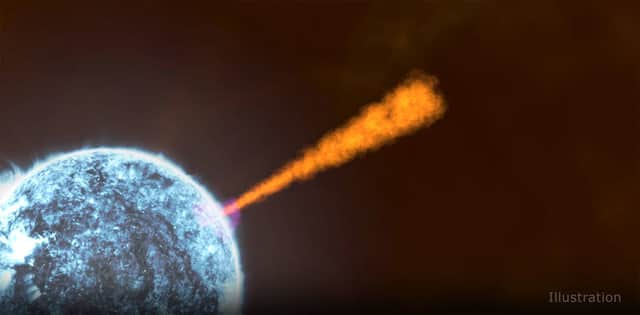Is this the brightest cosmic explosion of all time after the Big Bang? Gamma Ray Burst structures explained
and live on Freeview channel 276
Back in October 2022, scientists detected a gamma-ray burst (GRB), called GRB 221009A, which was quickly dubbed as the brightest of all time (BOAT). Now, researchers have discovered that the GRB had a unique jet structure that was dragging an unusual amount of material which was expelled during the explosion.
Gamma-ray bursts are known to be the most violent and energetic explosions in the universe, and release the same amount of energy in a few seconds that the sun will produce over its 10 billion-year lifetime. GRB 221009A was seen as a bright flash of high-energy gamma-rays, which was followed by a low-fading afterglow across various wavelengths of light.
Advertisement
Hide AdAdvertisement
Hide AdSo what is a gamma-ray burst, and what does GRB 221009A tell us about the nature of supernovas? Here is what you need to know.


What is a gamma-ray burst?
Gamma-ray bursts are the strongest and brightest explosions in the universe and are thought to be created during the formation of black holes. Since the Big Bang, these bursts are the most electromagnetic events in the universe and can last anywhere from ten milliseconds to a few hours.
The radiation emitted from most observed GRBs is thought to be released during a supernova, or a superluminous supernova as a result of a high-mass star imploding to form a neutron star or a black hole. Most GRBs occur billions of lightyears away, and all observed GRBs have come from outside the Milky Way - which also implies that they are both extremely energetic and extremely rare.
What has GRB 221009A shown us?
Researchers, who published their findings in the journal Science Advances, found GRB 221009A to be 70 times brighter and far more energetic than the previous record holder.
Advertisement
Hide AdAdvertisement
Hide AdThe researchers used NuSTAR observations of the vent to show how the collapsing star ejected the material into a shape that had not been previously observed. NASA states that it is possible the source of these distinctions is the progenitor star, or that there may be an entirely different mechanism that launches the brightest jets into space.
“This event was so much brighter and more energetic than any gamma-ray burst we’ve seen before, it’s not even close,” said Brendan O’Connor, lead author of the new study and an astronomer at George Washington University in Washington. “Then, when we analysed the NuSTAR data, we realised that it also has this unique jet structure. And that was really exciting, because we have no way of studying the star that produced this event; it’s gone now. But we now have some data giving us clues about how it exploded.”
The jet from GRB 221009A was significant as the jet had a narrow core, with wider, sloping sides. The energy of the material also varied, changing with distance from the jet’s core - which has never been observed before. The GRB was believed to be so intense as it was pointed directly to Earth.
“GRB 221009A represents a massive step forward in our understanding of gamma-ray bursts, and demonstrates that the most extreme explosions do not obey the standard physics assumed for garden variety gamma-ray bursts,” said Brendan O’Connor, GW graduate student and lead study author.
Advertisement
Hide AdAdvertisement
Hide Ad“GRB 221009A might be the equivalent Rosetta stone of long GRBs, forcing us to revise our standard theories of how relativistic outflows are formed in collapsing massive stars."
In May of this year, astronomers captured the largest cosmic explosion ever witnessed, lasting three years and so far releasing “about 100 times as much energy as the sun will in its 10 billion year lifetime.”
Comment Guidelines
National World encourages reader discussion on our stories. User feedback, insights and back-and-forth exchanges add a rich layer of context to reporting. Please review our Community Guidelines before commenting.
